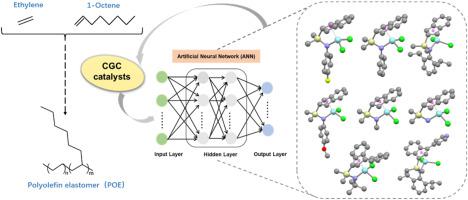Our official English website, www.x-mol.net, welcomes your feedback! (Note: you will need to create a separate account there.)
Computer-assisted design of CGC catalysts for ethylene/1-octene copolymerization: A combined DFT and artificial neural network approach
Polymer ( IF 4.6 ) Pub Date : 2024-04-01 , DOI: 10.1016/j.polymer.2024.126997 Shijia Wang , Xiutai Zhuo , Haonan Fan , Chengang Cao , Tao Jiang , Bing Yan
Polymer ( IF 4.6 ) Pub Date : 2024-04-01 , DOI: 10.1016/j.polymer.2024.126997 Shijia Wang , Xiutai Zhuo , Haonan Fan , Chengang Cao , Tao Jiang , Bing Yan

|
High temperature solution polymerization of ethylene/1-octene is the main means to produce polyolefin elastomer (POE), one of the most important polyolefin materials, and the metallocene catalysts with high-efficiency are the key to achieve POE production. However, there remains a deficiency in a universal approach for creating catalysts for ethylene/1-octene copolymerization. In this document, we outlined a method for designing catalysts for ethylene/1-octene copolymerization by combining density functional theory (DFT) with an artificial neural network (ANN) was proposed. By optimizing the structure and computing electronically a sequence of constrained geometry catalysts (CGC) by DFT, descriptors related to steric and electronic descriptors were gathered to create the dataset. After ANN training, an ANN-based model using for predicting catalyst activity with high value was optimized, and a class of novel highly efficient CGC have been successfully designed. Furthermore, an exploration was conducted into how the structure of catalysts correlates with their performance. The electronic properties of the catalysts were found to have more significantly effect on the catalytic performance than the steric properties. In addition, the effect of the β-site substitution of the cyclopentadienyl group on the catalytic activity of predicted CGC was studied and discussed. The groups with ring-structure, especially with conjugate system, were proved to possess a good promoting effect on the catalytic activity.
中文翻译:

用于乙烯/1-辛烯共聚的 CGC 催化剂的计算机辅助设计:DFT 和人工神经网络相结合的方法
乙烯/1-辛烯高温溶液聚合是生产最重要的聚烯烃材料之一聚烯烃弹性体(POE)的主要手段,而高效的茂金属催化剂是实现POE生产的关键。然而,制造乙烯/1-辛烯共聚催化剂的通用方法仍然存在缺陷。在本文中,我们概述了一种通过将密度泛函理论(DFT)与人工神经网络(ANN)相结合来设计乙烯/1-辛烯共聚催化剂的方法。通过优化结构并通过 DFT 以电子方式计算一系列约束几何催化剂 (CGC),收集与空间和电子描述符相关的描述符来创建数据集。经过ANN训练,优化了基于ANN的高价值催化剂活性预测模型,并成功设计了一类新型高效CGC。此外,还探索了催化剂的结构与其性能的关系。发现催化剂的电子性质对催化性能的影响比空间性质更显着。此外,还研究并讨论了环戊二烯基的β位取代对预测的CGC催化活性的影响。具有环状结构的基团,特别是具有共轭体系的基团,被证明对催化活性具有良好的促进作用。
更新日期:2024-04-01
中文翻译:

用于乙烯/1-辛烯共聚的 CGC 催化剂的计算机辅助设计:DFT 和人工神经网络相结合的方法
乙烯/1-辛烯高温溶液聚合是生产最重要的聚烯烃材料之一聚烯烃弹性体(POE)的主要手段,而高效的茂金属催化剂是实现POE生产的关键。然而,制造乙烯/1-辛烯共聚催化剂的通用方法仍然存在缺陷。在本文中,我们概述了一种通过将密度泛函理论(DFT)与人工神经网络(ANN)相结合来设计乙烯/1-辛烯共聚催化剂的方法。通过优化结构并通过 DFT 以电子方式计算一系列约束几何催化剂 (CGC),收集与空间和电子描述符相关的描述符来创建数据集。经过ANN训练,优化了基于ANN的高价值催化剂活性预测模型,并成功设计了一类新型高效CGC。此外,还探索了催化剂的结构与其性能的关系。发现催化剂的电子性质对催化性能的影响比空间性质更显着。此外,还研究并讨论了环戊二烯基的β位取代对预测的CGC催化活性的影响。具有环状结构的基团,特别是具有共轭体系的基团,被证明对催化活性具有良好的促进作用。



























 京公网安备 11010802027423号
京公网安备 11010802027423号